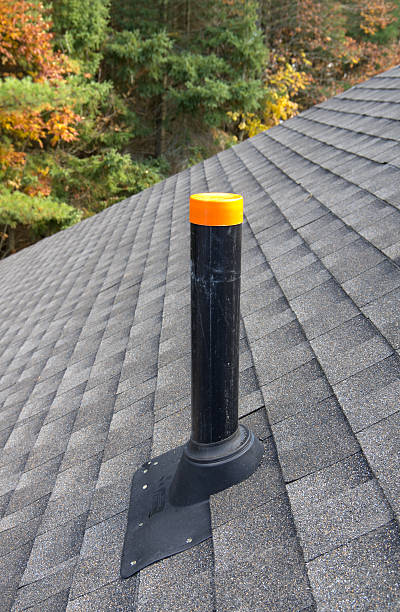Why Correct Ventilation Supports Your Plumbing System
Why Correct Ventilation Supports Your Plumbing System
Blog Article
The article author is making a number of good observations on Essential Plumbing Vent Pipes: Understanding Their Role overall in this content following next.

Proper air flow in pipes systems is frequently ignored, yet it is critical for preserving the functionality and safety of your home's pipes. Air flow assists control air pressure, prevent the buildup of unsafe gases, and guarantee the effective elimination of waste. In this overview, we will explore the significance of correct plumbing air flow, exactly how it works, and the benefits it brings to your plumbing system.
Recognizing Air Flow in Pipes
Ventilation in plumbing refers to the network of pipes that enable air to stream via the drainage system. These vents serve several functions, consisting of managing air pressure within the pipelines, protecting against sewage system gases from getting in the home, and aiding in the smooth flow of wastewater.
Just How Air Flow Works in Plumbing Systems
Air Pressure Policy
Appropriate air flow keeps balanced atmospheric pressure within the plumbing system. When water flows through pipelines, it displaces air. Without ample air flow, this displacement can develop unfavorable pressure, leading to slow down drains or siphoning of water from catches, which can trigger undesirable smells to permeate right into the home.
Avoiding Sewer Gas Build-up
One of the most essential features of plumbing vents is to avoid drain gases, such as methane and hydrogen sulfide, from building up within the home. These gases can pose major health and wellness threats and are very combustible. Vent pipelines permit these gases to leave securely outside.
Assisting in Waste Removal
Ventilation aids in the efficient removal of wastewater by stopping airlocks in the water drainage system. When air can flow easily with the vents, it allows water and waste to stream efficiently via the pipes, decreasing the threat of clogs and back-ups.
Types of Plumbing Vents
Main Heap Vent
The primary pile air vent, also referred to as the air vent pile, is the primary air vent in a pipes system. It expands from the primary drainpipe line up with the roof, enabling gases to run away and fresh air to go into the system.
Branch Vent
Branch vents attach to the main pile vent and serve private components, such as sinks, toilets, and showers. These vents make certain that each component has sufficient ventilation to work effectively.
Air Admission Shutoff (AAV).
An Air Admittance Shutoff (AAV) is a one-way shutoff that enables air to enter the pipes system without the demand for a traditional air vent pipeline expanding through the roof covering. AAVs are typically used in renovations or locations where installing a conventional air vent is impractical.
Indicators of Poor Air Flow in Plumbing.
Slow Draining Fixtures.
If your sinks, tubs, or bathrooms are draining pipes gradually, it could be a sign of poor air flow. Insufficient air circulation can produce a vacuum effect, making it challenging for water to drain appropriately.
Gurgling Seems.
Gurgling sounds originating from drains are frequently an outcome of air being drawn with water catches due to adverse pressure in the pipelines. This is a clear indication of inadequate ventilation.
Unpleasant Smells.
Sewer odors inside your home are a warning that your pipes system is not properly aerated. This might indicate that sewer gases are not being properly vented outside, leading to potentially harmful conditions.
Usual Ventilation Blunders.
Inadequate Vent Sizing.
Utilizing undersized vent pipes can bring about inadequate air circulation and pressure inequalities in the system. It's important to make use of vents that satisfy the certain demands of your pipes system.
Improper Vent Positioning.
Placing vents as well much from the components they offer can lower their effectiveness. Correct positioning makes certain that air can move freely and efficiently via the system.
Disregarding Code Demands.
Building codes provide details standards for plumbing air flow. Overlooking these codes can result in a system that stops working to work appropriately and may cause expensive repair work or health hazards.
Advantages of Proper Air Flow.
Boosted System Effectiveness.
Appropriately aerated pipes systems operate a lot more successfully, with less blockages, faster draining, and less stress on the pipelines. This efficiency prolongs the life expectancy of the plumbing system.
Improved Air High Quality.
By stopping drain gases from entering your home, appropriate air flow contributes to better interior air top quality, making your living atmosphere healthier and extra comfy.
Stopping Water Damage.
Adequate air flow helps avoid water from being siphoned out of catches, which can result in drain gases going into the home and triggering water damages gradually.
Actions to Guarantee Appropriate Air Flow.
Consulting Plumbing Codes.
Always consult neighborhood plumbing codes when making or changing your pipes system. These codes give the necessary standards for proper venting and ensure your system meets security requirements.
Normal Examination and Maintenance.
Regular inspections can help determine prospective ventilation issues before they end up being major issues. Maintenance jobs, such as cleansing air vent pipelines and checking for blockages, are necessary for keeping the system in good working order.
Expert Installation.
For new installations or significant alterations, it's smart to employ a professional plumbing. They have the competence to guarantee the air flow system is properly designed and mounted according to code.
Verdict.
Appropriate air flow is an important component of any type of pipes system, making certain that it functions effectively and securely. By comprehending the value of air flow, recognizing the signs of poor air flow, and taking actions to keep your system, you can prevent expensive issues and safeguard your home's air high quality.
4 Things You Should Know About Your Plumbing Vents
What Plumbing Vents Are
Also called a vent stack, a plumbing vent is a vertical pipe attached to your drain line that runs through your roof. The plumbing vent pipe, or plumbing air vent, removes gas and odors from your plumbing system and allows fresh air to enter the pipes, helping the water to flow out of the drain pipes.
What Plumbing Vents Do
Plumbing vents have two basic functions. One of which is to allow unpleasant smelling wastewater and sewer gasses to escape your plumbing system instead of entering your home. Plumbing vent pipes are typically located on roofs, away from windows, to ensure the fumes exit the home completely.
The other function of the plumbing vent is to move fresh air into your plumbing system. This helps move water through every plumbing fixture in your house, like toilets and sink drains. Think of the way in which you need to let a little air into the bottle as you pour soda in order to make the drink flow smoothly.
Different Types of Plumbing Vents
True vent: This is the most common vent option. In simplest terms, a true vent is a vertical pipe attached to your drain line that exits through the roof. They often function as the main vent that other fixtures can connect to. Re-vent pipe or auxiliary vent: Attached to the drain line near specific plumbing fixtures, re-vent pipes run up and over to connect to the main vent. Common vent: Two plumbing fixtures installed on opposite sides of a wall are typically tied into the vent stack using something known as a sanitary cross. Wet vent: This venting option operates as a drain pipe and a vent at the same time. Wet vent drainage systems drain water from one fixture while venting the air from another. Although they’ve been used for over 100 years, wet vent systems have only recently been added to the plumbing code in many areas. If you’re planning on installing one in a bathroom remodel, make sure you check your local code prior to construction. Loop vent: For free-standing fixtures like kitchen island sinks, loop vents are ideal. These vent pipes run under the floor, rise from the P-trap, and create a loop inside the cabinet sink. Air admittance valve: An AAV is a one-way mechanical valve typically installed at the site of the plumbing fixture. AAVs allow venting to occur without having to tie into a larger venting system. They’re ideal for venting fixtures where you aren’t able to easily connect to an existing vent system. Common Plumbing Vent Issues
Although vent pipes typically don’t have water flowing through them, they’re still subject to many typical plumbing issues. For example, clogs are one of the most common problems associated with sewer vent pipes. If your vent pipe gets clogged, all of your plumbing fixtures tied into the vent stack will be affected.
A sink with a slow drain that bubbles and gurgles or a strong sewage smell around your toilet are both indicators that your toilet vent pipe is clogged. Because most vent pipes exit through the roof, old leaves, twigs or even a bird’s nest could be clogging the pipe.
Clogs in your vent pipe system cause a buildup of negative pressure, meaning that water won’t be able to flow out of your home very well. It’s similar to putting your finger over the opening of a straw to trap water inside. When you remove your finger, the water is able to flow out of the straw.
If you suspect you have any blockage in your vent, make sure you have a professional come examine the situation. Left unchecked, a blocked air vent can lead to other costly repairs, like leaks and sediment buildup.
Under Pressure
Pipe vents are essential aspects of a home’s plumbing system. Owning a home means learning about all sorts of things you never put much thought into before. But by understanding as much as you can about the important systems of your home, you can keep those budgets intact and those anxiety levels low.
https://www.homeserve.com/en-us/blog/home-improvement/plumbing-vents/

We were made aware of that write-up about Why Plumbing Air Vents Are Important through someone on our other site. Enjoyed our blog? Please share it. Let other people check it out. We take joy in reading our article about What Are Plumbing Vents and Why Are They Important?.
Call Today Report this page